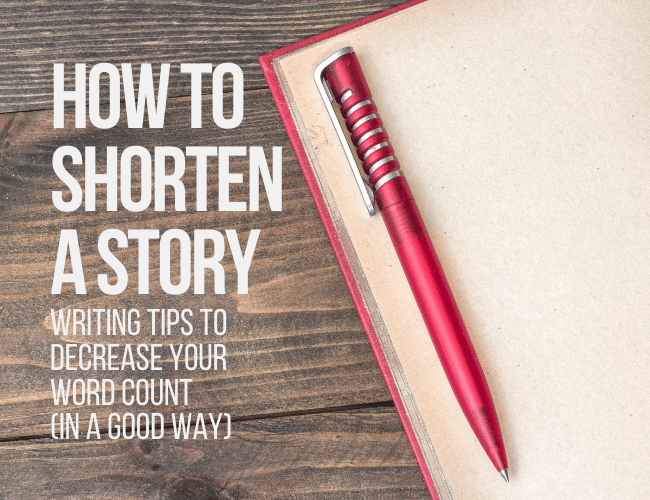Short stories are their own art form. In a novel, you have an entire book to elaborate, to make your readers care. In a short story, you have to have the same elements, but in about two percent of the words. How can you reduce word count to tell the best story?

Ultimately, learning how to write a story in fewer words takes practice. Luckily, tightening a short story into an even shorter story is something you can get the hang of over time.
This article shares various, easy writing tips that can help you cut down word count—and make your short story all the better for it. And while this article is specifically about short stories, you could use this method as a part of your writing process for any type of writing from academic papers to less formal writing projects.
A Good Short Story Takes Practice
I wrote about how I used to end my stories in the middle of the climax in a previous article on the basic elements of a short story. I also used to think paragraphs of long descriptions were the mark of a good piece of writing.
It took me years to understand what qualified as good writing, especially good writing in a short story. One of the main components of these “good” short stories is that they focus on clarity and purpose over purple prose.
Following the advice of a much better short story writer than me, I spent an afternoon highlighting every word in a short story of mine. I had about eight different colors of highlighters and the manuscript looked like a rainbow when I finished.
Each color served a purpose: one for highlighting -ly and -ing words, one for descriptions, one for dialogue tags, and so on. This strategy allowed me to assess if each sentence moved the story along. It also highlighted areas I should cut.
When I made these cuts, I had a lot more room and was able to write a more compelling story.
My stories got better because I wasn’t wasting space with “word baggage.”
You might ask why a writer would want to make their story shorter. Stories end when the writer is done telling the story, right?
And in general, that's true. But if you're trying to get your story into a literary magazine, a literary journal, or entering it into a writing contest, you will most likely have to come in under a maximum word count.
You're going to have to cut the fat.
Writing Tips That Will Tighten Your Short Story
To avoid a short story full of unnecessary words and very little plot, you need to learn to tighten your prose, eliminating wordy phrases and making every word choice work hard.
Here are some writing tips you can use to shorten your word count:
1. Narrow your story scope
Short stories are, obviously, short. Therefore, they need to be simple.
Your stories should focus on a single character, have a small supporting cast of characters, and revolve around one simple idea (no subplots!).
Narrow your scope to one slice of your character’s life. If you try to fit too much into a short story, often it will feel disjointed, not make sense, and not have a satisfying ending.
Quick tip: If your short story takes place over the course of weeks or even months, it’s a sign you might need to narrow your scope.
2. Efficiency is the key
Small word counts mean each sentence needs to be earning its keep. Make sure you’re writing in active voice rather than passive voice to avoid using more words than necessary.
When your characters are speaking, make sure their words are realistic, but also necessary. Avoid hemming and hawing, unless it's for the purpose of character development. Try not to use florid dialogue tags—stick to “said” instead of wordy phrases to describe the dialogue tag.
Also, don’t get verbose when describing something. If two words can be combined into one stronger word, do it.
It’s about quality, not quantity.
Quick tip: Forms of to be indicate passive writing. Rewrite to make your sentence active. For example:
- Active voice: The dog chased the mailman.
- Passive voice: The mailman was chased by the dog.
To address passive voice, ask yourself who is doing the action, and make sure they are up front in the sentence. (Unless you're using passive voice on purpose for a specific effect.)
3. Start as close to the end as possible
There is a very short setup in short stories before the inciting incident hits your character. Hit the ground running and get your character in trouble as quickly as possible.
In Shirley Jackson’s “The Lottery,” the villagers are already gathering on the green at the start of the story, ready for the lottery drawing, which is the central conflict.
Quick tip: Short stories often skip exposition and get right to the inciting incident in the first lines. If your story starts with a lot of exposition, consider cutting it.
Often, you can cut the first two or three paragraphs from your first draft without compromising the story.
[If you need a refresher on what makes a complete story and basic story structure, see this article.]
4. Keep a faster pace
Short stories need to move quickly and are constantly moving toward the climax. They do not take the scenic route; it’s a straight beeline all the way.
In novels, the pace picks up the closer to the climax you get, but in short stories, you’ve already started super close to the climax, so it needs to be fast all the way through.
Quick tip: Watch out for flashback scenes. They rarely contribute to short stories. Try to stay in the present moment as much as possible, and that will speed up your pacing.
5. Suggest a backstory, but don’t elaborate
Is it necessary for the reader to know where your main character went to elementary school? Probably not, unless it’s super relevant to the story.
Concentrate on what’s necessary for the story, what moves the plot along, not every detail about every character.
This doesn’t mean that the writer can't know every detail of a character’s life, but the reader doesn’t need all that information.
Any kind of biography of your characters should be scrutinized. If it doesn’t reveal character or move the story along, get rid of it.
Quick tip: Try cutting out the background information on your characters. Does the story still make sense? If so, you can probably safely cut those sentences. If it doesn’t make sense, is there a way you can condense that information?
6. Don’t spend a lot of time world-building/scene-setting
As with backstory, when you're trimming your world-building, ask yourself, “What do my readers need to know right now in order for this to make sense?”
Don’t ignore the setting entirely, but concentrate more on how your character is interacting with the setting than describing it.
It’s unnecessary to spend several paragraphs describing a sweltering hot day when you could just show your character’s shirt clinging to them to indicate intense sweating. And that's way more interesting to your reader.
Quick tip: Use a highlighter to highlight all the blocks of description in your short story. The large blocks of highlighted text need a closer look. Can you condense the description there?
7. Rely on readers’ imagination/life experience
Trust your reader’s intelligence. They are more intelligent than a lot of writers give them credit for, and often get bored if spoonfed information.
Instead of explaining every detail, let readers fill in the gaps. For example, in the following sentence, you can most likely fill in the rest of this person’s physicality without me needing to describe her fully.
Her hair was gray, but tidy, and glasses hung on a beaded rope around her neck.
This sentence gives the impression of a person, and that’s good enough to move forward with the story.
Quick tip: Look for areas in your story where you can rely on universal reader experience and stereotypes to fill in gaps. Especially look for these things when introducing setting or unimportant secondary characters.
For example, a greasy spoon diner, a cashier popping gum, or a grocery store probably need little more description than what I’ve given in this sentence.
8. Cut unnecessary words
If a sentence still makes sense without a certain word, cut the word.
Words like “that” and “really” rarely contribute to the meaning of a sentence and can be cut.
Phrases like “in order to” are often useless. Keep an eye out for the following words and phrases. When you find them, see if you can use stronger words or cut the word altogether.
Quick tip: Here are some others you might want to cut.
- Up, down (when preceded by sit/sat or stand/stood)
- That, just (most likely can be cut without changing the meaning of the sentence)
- Really, rather, very
- Think, thought, felt, feel, heard, hear (can just describe the sensory experience)
- Honestly, however, meanwhile
- Totally, absolutely
- Start/begin/began
- -ly, -ing words, and any forms of to be (normally indicate passive writing)
Every Detail Needs to Earn Its Keep
In a short story, you’re focusing on one goal and getting to that goal in the most efficient way possible. Tangents, side-quests, and meandering need not apply.
When you’re working on tightening a short story, make sure every sentence and every word is earning its keep by either moving the story along, revealing character, or giving a succinct description.
If you’re not sure if something should be included in your story, leave it out.
How do you tighten your short stories? Let us know in the comments.
PRACTICE
Today, let’s practice on how to tighten passages and prose. Take fifteen minutes to improve this passage by condensing it. Remember to keep an eye out for those words and phrases I mentioned above.
The sun popped up out of the horizon like a balloon let go by a child’s plump hand. The morning was warm, warmer than it needed to be at this time of year. Glory was waking up. She smelled the waffles that her mother was cooking downstairs. The aroma caused her stomach to growl loudly.
As she started to get up out of bed, she realized today was Monday and that she would have to go to school.
“Hurry up, sleepyhead!” her mother called up the stairs.
Glory rushed through the morning routine and headed downstairs.
“You’ll be getting picked up by your dad after school today,” her mom said once she had sat down at the table and began eating her breakfast.
When you’re done, share what you cut in the Pro Practice Workshop, how this exercise went, and your edited version of this passage.
And don’t forget to give some feedback to your fellow writers!
Sarah Gribble is the author of dozens of short stories that explore uncomfortable situations, basic fears, and the general awe and fascination of the unknown. She just released Surviving Death, her first novel, and is currently working on her next book.
Follow her on Instagram or join her email list for free scares.

0 Comments